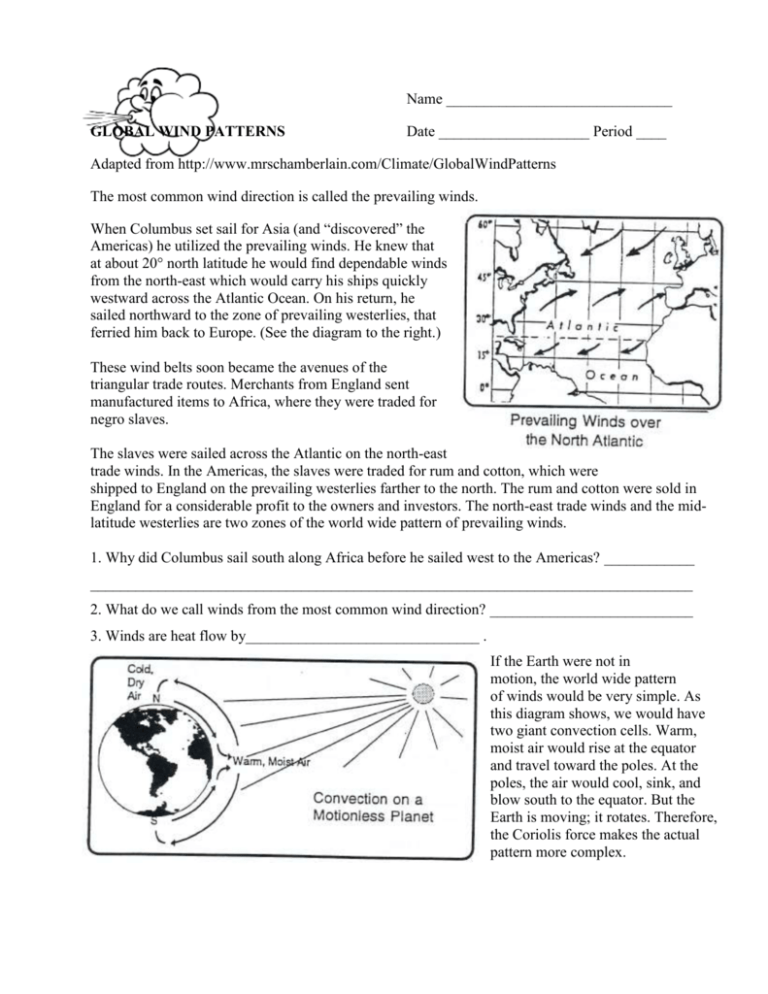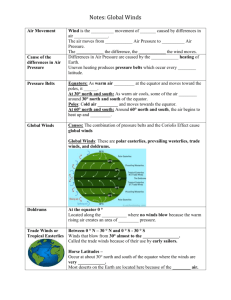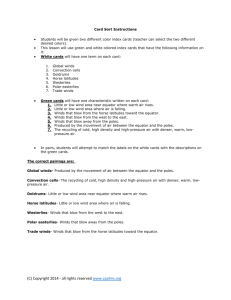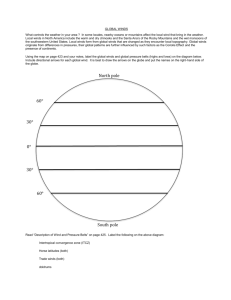Name GLOBAL WIND PATTERNS Date Period ____ Adapted from
advertisement

Name ______________________________ GLOBAL WIND PATTERNS Date ____________________ Period ____ Adapted from http://www.mrschamberlain.com/Climate/GlobalWindPatterns The most common wind direction is called the prevailing winds. When Columbus set sail for Asia (and “discovered” the Americas) he utilized the prevailing winds. He knew that at about 20° north latitude he would find dependable winds from the north-east which would carry his ships quickly westward across the Atlantic Ocean. On his return, he sailed northward to the zone of prevailing westerlies, that ferried him back to Europe. (See the diagram to the right.) These wind belts soon became the avenues of the triangular trade routes. Merchants from England sent manufactured items to Africa, where they were traded for negro slaves. The slaves were sailed across the Atlantic on the north-east trade winds. In the Americas, the slaves were traded for rum and cotton, which were shipped to England on the prevailing westerlies farther to the north. The rum and cotton were sold in England for a considerable profit to the owners and investors. The north-east trade winds and the midlatitude westerlies are two zones of the world wide pattern of prevailing winds. 1. Why did Columbus sail south along Africa before he sailed west to the Americas? ____________ ________________________________________________________________________________ 2. What do we call winds from the most common wind direction? ___________________________ 3. Winds are heat flow by_______________________________ . If the Earth were not in motion, the world wide pattern of winds would be very simple. As this diagram shows, we would have two giant convection cells. Warm, moist air would rise at the equator and travel toward the poles. At the poles, the air would cool, sink, and blow south to the equator. But the Earth is moving; it rotates. Therefore, the Coriolis force makes the actual pattern more complex. This diagram shows the true pattern of Earth’s prevailing winds. Notice how the winds curve to the right in the northern hemisphere and to the left in the southern hemisphere. Notice how the winds in the southern hemisphere are a mirror reflection of the northern hemisphere winds. Most of the wind belt names are easy to understand, but the doldrums may be unfamiliar. The doldrums are the regions of weak and undependable winds near the equator, where warm moist air is often rising. 5. According to the map above, near the poles, the winds usually blow from the __________________ 6. Winds always blow from____________ pressure toward __________________pressure, and they curve because of the _______________________effect. Vertical profiles of Earth’s atmosphere from the North Pole to the South Pole. 7. Along the equator, the air movies mostly along the Earth, or up higher into the atmosphere. (Circle one choice) 8. Why is the climate often wet near the equator? _________________________________ The Earth’s surface is constantly being heated by energy from the sun. Because tropical regions are warmed more effectively than polar regions, differences in atmospheric pressure develop between these latitude extremes. Such pressure differences result in planet wide winds. Air heated at the surface in the lower latitudes is lifted and replaced by cooler, denser air flowing from the higher latitudes. If the Earth did not rotate, if it was not inclined on its axis, and if the surface was uniform throughout, planetary atmospheric circulation would probably be relatively simple. Alas, such is not the case! In fact, global wind systems are extremely complex, and details of worldwide wind patterns are still not clearly understood by earth scientists. However, basic circulation patterns recognized by scientists do exist, and they are used to help understand certain worldwide climate and weather patterns. The purpose of this activity is to examine the location and extent of some of the general planetary wind and pressure systems that are currently recognized by earth scientists. In order to complete this activity, you will need to keep three facts in mind: 1. Air tends to flow out of regions characterized by relative high pressure and into regions characterized by relative low pressure. 2. Because of the Earth’s rotation, winds tend to be deflected or directed toward the right in the Northern Hemisphere and toward the left in the Southern Hemisphere. 3. Winds are named for the direction from which they originate. For example, a north wind is one that flows from the north. Now refer to Figure 1, which represents a rough sketch of the Earth. Note that the locations of the equator (latitude 0°), the poles (latitude 90°), and latitudes 30° and 60° have been identified. Additional information will be added to the map as you complete this activity. On the right side of Figure 1 and in the appropriate space provided, label each of the seven pressure belts. The equator is a low-pressure belt and is referred to as the equatorial low. Latitudes 30° north and south are high-pressure zones and are each referred to as a sub-tropical high. Latitudes 60° north and south are low-pressure belts and are each known as a sub-polar low. Finally, the polar regions are high-pressure zones and each should be labeled as a polar high. In the proper location, sketch in the direction of planetary wind movement within each global wind belt. Use several arrows in each zone to illustrate the direction of deflection, as shown in the following key. Be sure to place directional arrow, right on the map, within all six wind belt regions. On the left side of Figure 1 and in the appropriate space provided, label the names of the wind belts. Remember that winds are named for the direction from which they flow. Winds located between latitudes 0° and 30° are known as trade winds. Thus, if winds within this zone originated in the northeast, they would be known as northeast trades. Winds located between latitudes 30° and 60° are referred to and named by the direction from which they originated. They are further described as prevailing winds. Thus, if winds within these zones originated in the northwest, they would be referred to as prevailing northwesterlies. Winds located between latitudes 60° and 90° (the North or South poles) are referred to as polar winds. Therefore, winds located in these zones, which originate in the east, are known as polar easterlies. 1. What causes winds to be deflected to the right or the left as they flow from high pressure to low pressure? _____________________________________________________________________ 2. Name the wind belt in which you live. _______________________________________________ 3. Name the winds that would be found at location X (refer to Figure 1). ______________________ 4. Why is air pressure generally lower over equatorial regions than over polar regions? __________ ________________________________________________________________________________









